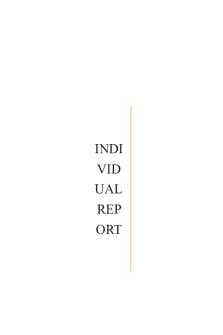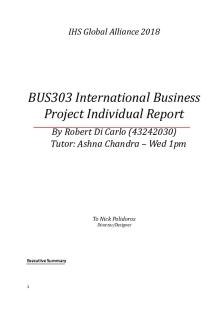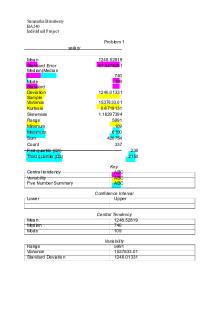Individual Report- Edumondo PDF

| Title | Individual Report- Edumondo |
|---|---|
| Course | International Business Strategy |
| Institution | Glasgow Caledonian University |
| Pages | 7 |
| File Size | 132.2 KB |
| File Type | |
| Total Downloads | 49 |
| Total Views | 153 |
Summary
Report discusses the implementation of CSR policies on the fiction company of Equipd, in relation to the Edumondo event ...
Description
INTERNATIONAL BUSINESS STRATEGY - M3N222479 Instructions: Complete and attach this form to the front of your coursework prior to submission, confirming that you have included each of the required sections of the portfolio by ticking each box. Student Name: Matriculation Number: Seminar day and time: Wednesday 11am Seminar Tutor name: Turnitin Score: Word count: 1,520
“The piece of coursework that I am submitting for International Business Strategy [M3N222479] is my original work, and has not been submitted elsewhere in fulfilment of the requirement of this or any other award”.
PART TWO: Individual Report – structured into the following sections: Contents page*
√
Section One – Implementation
√
Section Two – Evaluation of firm’s strategy
√
Section Three – Evaluation of team and self
√
References
√
Contents Page Implementation of CSR Policies
3
Evaluation of Firm’s Strategy
5
Evaluation of Team and Self Team Self
6 6 6
References
7
Implementation of CSR Policies Throughout the duration of the Edumondo event, all Equipd members made multiple executive decisions that would impact the firm's cost and sales, therefore having an effect on the overall profit generated by the firm. While making those decisions, the CSR policy of the firm had to be evaluated to ensure that all decisions made followed the policies created. Corporate Social Responsibility (CSR) is an approach made by a business that contributes to global sustainable development by delivering economic, social and environmental benefits for all stakeholders (Financial Times, 2018). While CSR policies can generate higher profit yields, it is also implemented for moral reasons to limit the effect of the business on the environment and to become sustainable. By considering CSR into our decision-making process, we were able to reduce risk by considering other external factors. The general CSR strategy of Equipd is to be an ethically engaged organisation, that ensures our product have high-quality working conditions with strong working rights. As our business follows a premium pricing strategy, we believe that premium price should be reflected in working conditions and the sustainable of the business. A major CSR policy of Equipd is its work with national UK sporting charities. Currently, 5% of all tennis racket sales go towards charities and then working with those charities to ensure that the donations are used in a meaningful way. An example of this is to provide equipment for disability football, while also creating match events where prize money was donated to the winning team. After conducting staff satisfaction surveys, it was noted that satisfaction was not at acceptable levels compared to their overall CSR strategy. To resolve this, changes were made in the first year to increase sales pay and working conditions. Working conditions were increased as by following Herzberg theories of motivation; workers are motivated by anything other than money, such as praise, achievement, responsibility and advancement (Hong Tan and Waheed, 2011). So changes other than changes to pay increase are just as essential as changes to staff pay. The sales manager was also changed to be Joseph Peter, whose style of management was described as an alternating focus on work and by doing fun events with coworkers to create a healthy working environment. After the changes were made, improvements relating to staff motivation were instant, reaching our internal CSR goals. A CSR policy used by Equipd is strong self-regulating rules for ethical advertising. Ethical advertising is a socially responsible way of advertising and includes factors such as truthfulness, messaging and avoiding public cynicism. For a truthful advert, it must not distort statistical figures so to not deceive viewers. An example of deceitfulness is to advertise a product at a low price, and then adding hidden fees behind the purchase that are either mandatory or would detract from the product if not added, such as booking fees (Stewart, 1972). The messaging of advertising the product should not promote anything that could be considered damaging to society. What is considered damaging can be vague, however promoting stereotypes,
irresponsible alcohol or sexual behaviours, or attempts to emotionally manipulate a vulnerable audience would be considered socially irresponsible (Bachnik and Nowacki, 2018). Equipd ensured that their advertising is socially responsible through transparently, by never lying to their customer base, and making clear exactly what their product entails. This was done so that customers were fully aware of the product and to build trust with the customer base While having a strong CSR strategy is good for creating sustainability and moral reasons, it can also be used to create a competitive advantage. CSR generates competitive advantage with how it can be used to distinguish businesses from other competitors, such as Equipd has through donating 5% of its tennis proceeds to charity. This can be used in advertisements to tempt potential consumers to purchase the product over a competitor, as consumers may feel better as a per cent of their purchase goes towards a cause (Cegliński and Wiśniewska, 2017). According to a survey of 30,000 respondents from 30 different countries; 66% of consumers have said that they will pay more for a brand or product that follows CSR policies (Nielsen.com, 2015), so having sustainable policies helps Equipd justify their premium price to potential customers.
Evaluation of Firm’s Strategy The firm performed outstanding well, as it topped the stock exchange for the majority of trading periods. The strategy chosen within the initial meetings was to use a premium pricing strategy throughout the product, through an initial increase in price and then adjusting the price based on the market reaction and market research to the initial increase. The market responded very well to our strategy, as Equipd made £80,000 profit and rose to the top of the stock exchange in its first year under new management. This resulted from decisions made by management in seminar meetings to not only use a premium pricing strategy but investing heavily in marketing the products. By doing market research into the budgeting of the firms' local competitors, it was noticed that Equipd outspent competitors by a margin of at least £6,000 (compared to the second highest spender), by spending £24,000 on yearly basis. A change in one metric that unintentionally impacted another metric was related to staff satisfaction concerns. It was noted in year 3 that staff satisfaction was low so changes were implemented to improve satisfaction. Those changes were a £1,000 sales pay increase, improve the training budget, and improving on working conditions. The changes were successful at improving staff satisfaction but did however reduce the metric for the amount of profit and growth the firm had in the following years. Overall, the premium pricing strategy was very successful for the firm. The yearly profit was high but unpredictable, an example being £84,259 in year 6 but £14,321 in year 7. However, there was continually yearly growth on the stock exchange, with Equipd reaching the top of the exchange multiple times, and finishing the final trading year as the most valuable company on the exchange.
Evaluation of Team and Self Team The team made an active effort as it developed to follow Tuckman's model. Tuckman’s model involves 4 stages of Forming, Storming, Norming, and Performing that a collection of strangers that have united as a group with common goals will go through as they form together as a team (Wilson, 2010). Thankfully, there weren’t any conflicts within the group as it went through the stages, but evidence can be seen of the formation as there at first no set time for meetings, instead just happening whenever was suitable for that week. However, as the team moved away from the formation stage there was an agreed upon set time for meetings that worked well for everyone. During this stage there was also agreed upon roles for each member; I would take notes for the decisions made for the business, Sarah would take minutes, and Michael and Rachel would evaluate the results from previous years market research results and scorecard and suggest changes to improve the business. This method proved successful as it allowed us to quickly evaluate the past weeks' performance and make informed decisions as a group for how to proceed. If there was something that could have been done differently it would have been a greater focus on purchasing. This could have been improved as there were times where we wrongly predicted the demand for products, leading to high unsold inventory. For the future, there would need to be a process in place to ensure that order numbers follow a Just-In-Time system. A Just-In-Time system is a management strategy that aims to align raw materials from suppliers with the production of the product. This increases efficiency and decreases potential waste as the goods received are moved straight to the production process, reducing inventory build up (Cathcart, 2007).
Self As the team developed, my communication skills were used and improved upon. Communication is the most important skill needed to unite a team, as for a group to succeed every member should feel understood and listened to. This was developed by having clearly defined roles for each member and ensuring that each member knows what they would like to achieve with the group project. However, I felt communication was damaged after weekly meetings were disbanded following the completion of the simulation and team communication transferred to online messaging. During the project, I learnt that one of my professional strengths is being honest if I disagreed with a decision made by a team member. I felt that a group atmosphere was created where we were able to have a healthy debate and come to a conclusion as a team over what decision to take, resolving any disagreements. To continue having that strength in group work, I should focus to create a healthy atmosphere for debate. A personal weakness I noticed was time management, as in the beginning I was slow to organise meetings and was late to agree upon delegated roles for the group project. In the future, I would
aim to remedy this by having set dates for certain events of significance to the project.
References Bachnik, K. and Nowacki, R. (2018). How to Build Consumer Trust: Socially Responsible or Controversial Advertising. Sustainability, 10(7), p.2173. Cathcart, R. (2007). Just in Case, or Just in Time?. The Reference Librarian, 48(2), pp.61-65. Cegliński, P. and Wiśniewska, A. (2017). CSR as a Source of Competitive Advantage: The Case Study of Polpharma Group. Journal of Corporate Responsibility and Leadership, 3(4), p.9. Financial Times (2018). Corporate Social Responsibility (Csr) Definition from Financial Times Lexicon. [online] Available at: http://lexicon.ft.com/Term?term=corporate-socialresponsibility--(CSR) [Accessed 10 Jan. 2019]. Hong Tan, T. and Waheed, A. (2011). Herzberg’s motivation-hygiene theory and job satisfaction in the malaysian retail sector: the mediating effect of love of money. Asian Academy of Management, 16(1), pp.73-94. Nielsen.com. (2015). The Sustainability Imperative: New Insights On Consumer Expectations. [online] Available at: https://www.nielsen.com/content/dam/nielsenglobal/dk/docs/globalsustainability-report-oct-2015.pdf [Accessed 10 Jan. 2019]. Stewart, D. (1972). Truth in Advertising. Journal of Advertising, 1(1), pp.48-49. Wilson, C. (2010). Bruce Tuckman's Forming, Storming, Norming & Performing Team Development Model. Culture Atwork, pp.1-3....
Similar Free PDFs

Individual Report- Edumondo
- 7 Pages

Individual Report
- 14 Pages

ACCG1001 Individual Report
- 6 Pages

BUS303 Individual Project Report
- 23 Pages

Report - Assignment 2 : Individual
- 11 Pages

BA240 Individual Report Brimb
- 6 Pages

Individual Report Walmart
- 7 Pages

Individual Report - 2
- 3 Pages

Individual Report - Marketing Audit
- 20 Pages

Individual Market View Report
- 7 Pages

Individual Group Report
- 10 Pages

Uber in China Individual report
- 4 Pages

Individual report Part B 11167
- 9 Pages
Popular Institutions
- Tinajero National High School - Annex
- Politeknik Caltex Riau
- Yokohama City University
- SGT University
- University of Al-Qadisiyah
- Divine Word College of Vigan
- Techniek College Rotterdam
- Universidade de Santiago
- Universiti Teknologi MARA Cawangan Johor Kampus Pasir Gudang
- Poltekkes Kemenkes Yogyakarta
- Baguio City National High School
- Colegio san marcos
- preparatoria uno
- Centro de Bachillerato Tecnológico Industrial y de Servicios No. 107
- Dalian Maritime University
- Quang Trung Secondary School
- Colegio Tecnológico en Informática
- Corporación Regional de Educación Superior
- Grupo CEDVA
- Dar Al Uloom University
- Centro de Estudios Preuniversitarios de la Universidad Nacional de Ingeniería
- 上智大学
- Aakash International School, Nuna Majara
- San Felipe Neri Catholic School
- Kang Chiao International School - New Taipei City
- Misamis Occidental National High School
- Institución Educativa Escuela Normal Juan Ladrilleros
- Kolehiyo ng Pantukan
- Batanes State College
- Instituto Continental
- Sekolah Menengah Kejuruan Kesehatan Kaltara (Tarakan)
- Colegio de La Inmaculada Concepcion - Cebu


